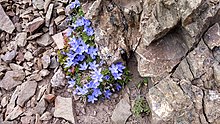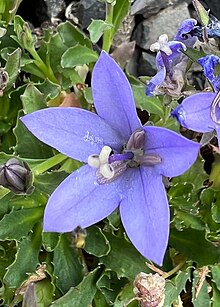
Campanula is the type genus of the Campanulaceae family of flowering plants. Campanula are commonly known as bellflowers and take both their common and scientific names from the bell-shaped flowers — campanula is Latin for "little bell".

Campanula americana, the American bellflower, or tall bellflower, is a bellflower native to eastern North America. Tall bellflowers can be annual or biennial with a varying life-history with seeds germinating in the fall producing annual plants and spring-germinating seeds producing biennial plants. Long-tongued bees are the primary pollinators, including Megachile campanulae, but halictid bees, butterflies, and skippers may also act as pollinators. Tall Bellflowers do not generally self-pollinate. Some authorities, including the USDA PLANTS database, consider the name Campanulastrum americanum to be the accepted name for this species.

Campanula latifolia, the giant bellflower, is a species of bellflower in the family Campanulaceae. It is also known as the large campanula and the wide-leaved bellflower. It is native to Europe and western Asia and is widely grown as an ornamental plant.

Campanula trachelium, the nettle-leaved bellflower, is a species of bellflower. It is a Eurasian blue wildflower native to Denmark and England and now naturalized in southeast Ireland. It is also found southward through much of Europe into Africa.

Campanula rapunculoides, known by the common names creeping bellflower, rampion bellflower, rover bellflower, garden bluebell, creeping bluebell, purple bell, garden harebell, and creeping campanula, is a perennial herbaceous plant of the genus Campanula, belonging to the family Campanulaceae. Native to central and southern Europe and west Asia, in some parts of North America it is an extremely invasive species.
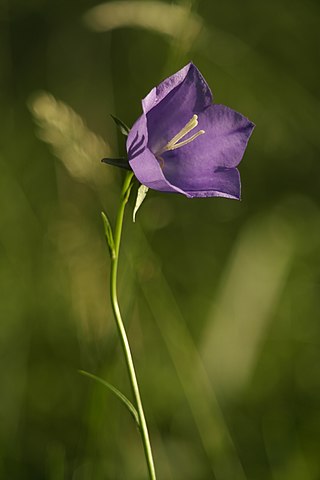
Campanula persicifolia, the peach-leaved bellflower, is a flowering plant species in the family Campanulaceae. It is an herbaceous perennial growing to 1 m. Its flowers are cup-shaped and can be either lilac-blue or white. Its foliage is narrow and glossy with a bright green appearance.

Campanula rapunculus, common name rampion bellflower, rampion, rover bellflower, or rapunzel, is a species of bellflower (Campanula) in the family Campanulaceae.
Campanula angustiflora is a species of flowering plant in the bellflower family Campanulaceae. It is known by the common name Eastwood's bellflower. It is endemic to California, where it grows in the serpentine soils of the hills and mountains surrounding the San Francisco Bay Area. It is a flower of the chaparral plant community. This is a hairy annual herb producing a thin, branching stem up to 20 centimeters tall. The leaves are leathery in texture and oval in shape, measuring between 0.5 and 1 centimeter in length, with a few teeth along the edges. The bell-shaped flower is pale blue or white and just a few millimeters long. The fruit is a ribbed, spherical capsule.
Campanula californica is a species of flowering plant in the bellflower family Campanulaceae, known by the common names swamp bellflower and swamp harebell. It is endemic to California, where it grows along the coastline between Marin and Mendocino Counties. It is found mainly in wet areas such as bogs, marshes, and wet forest floors. This is a hairy rhizomatous perennial herb producing a thin, creeping stem 10 to 30 centimeters long. The thin, rippled leaves are oval in shape and between 1 and 2 centimeters long. The bell-shaped flower is pale blue with curving petals up to 1.5 centimeters long. The fruit is a ribbed, spherical capsule.

Campanula scouleri is a species of bellflower known by the common names pale bellflower and Scouler's harebell. It is native to the mountains of western North America from northern California to Alaska.

Campanula sharsmithiae is a rare species of bellflower known by the common names Mt. Hamilton bellflower and Sharsmith's harebell. It is endemic to California, where it is known from just a few occurrences in the higher mountain peaks just south of the San Francisco Bay Area, including Mt. Hamilton and Mount Boardman in the Diablo Range. It is a small, hairy annual herb producing an erect stem up to 25 centimeters tall. The fleshy, toothed leaves are a centimeter long or less. The flower is funnel- or bell-shaped and purple in color. The plant is named for late local botanist Helen Sharsmith.

Campanula wilkinsiana is a rare species of bellflower known by the common name Wilkins' bellflower.

Campanula alliariifolia is a species of flowering plant in the bellflower family Campanulaceae. It is native to the Caucasus and Turkey and it is grown as an ornamental plant. Common names include Cornish bellflower.
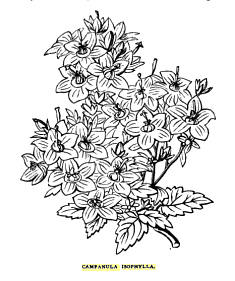
Campanula isophylla is a species of plant. The common names of the species include Italian bellflower, star of Bethlehem, falling stars and trailing campanula.

Favratia zoysii, known commonly as Zois' bellflower, Zoysi's harebell, or crimped bellflower, is the sole member of the genus Favratia, closely related to Campanula (bellflowers).

Campanula punctata, the spotted bellflower, is a species of flowering plant in the bellflower family Campanulaceae. This ornamental herbaceous perennial is native to Japan, Korea, China and Siberia, and is widely cultivated for its attractive bell-shaped flowers.
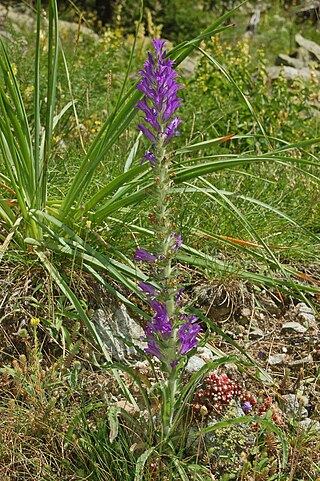
Campanula spicata, common name the spiked bellflower, is a herbaceous biennial or perennial plant of the genus Campanula belonging to the family Campanulaceae.

Solidago ouachitensis is a North American species of flowering plants in the family Asteraceae known by the common name Ouachita Mountain goldenrod. It has a very limited range, found only in the Ouachita Mountains along the border between Arkansas and Oklahoma in the United States.
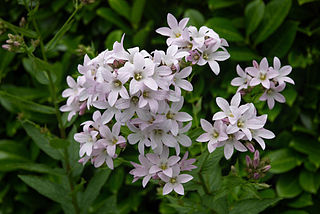
Campanula lactiflora, the milky bellflower, is a species of flowering plant in the genus Campanula of the family Campanulaceae, native to Turkey and the Caucasus. It is a medium-sized herbaceous perennial growing to 1.2 m, with narrow, toothed leaves 5–12 cm (2–5 in) long. Large conical clusters of open, star-shaped flowers are produced on branching stems in summer. In favourable conditions it will self-seed with variable results. The flowers are usually white or pale blue, but numerous cultivars have been developed for garden use, in a range of colours.

Campanula petiolata, is a wild flower that is called western harebell when it is distinguished from Campanula rotundifolia or simply harebell when it is considered the same species. It is a species of flowering plant in the bellflower family Campanulaceae. This herbaceous perennial is found through much of the temperate areas of North America. It produces its violet-blue, bell-shaped flowers in late summer and autumn. It is closely related to Campanula rotundifolia and is considered either a subspecies or the same species by many botanists.
